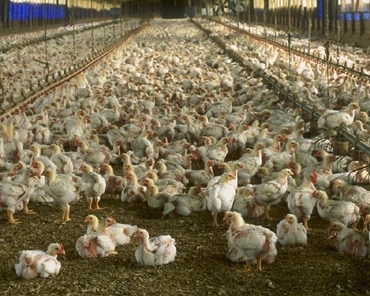These buildings had 18,000 square feet inside, and housed 20,000 to 40,000 meat chickens. Most buildings average 36,000 chickens per building, making a total of 216,000 chickens in that one area.
I thought about just how well the industry has hid these things from sight; A lot of people pass by that farm everyday and never realize what's inside...
Cramped in their dark, dusty, ammonia-reeking homes for 8 weeks, these 'broilers' (term for meat chicken) can barely move due to their unnaturally large size and suffer from numerous illnesses such as ammonia burns, respiratory diseases and crippled legs. They can do nothing but eat food that is placed in front of them, and grow fat.
When their 8 weeks are up, they are loaded onto a truck, to be slaughtered, by Latino-American, and Mexican workers, who speak no English (the industry uses foreign workers specifically because they don't speak English. If they can't speak English, then they can't tell anyone about what's going on.), are treated badly, and are payed a small pension for their work.
And yet, by looking at those huge buildings, you might never guess that they had such a story behind their walls...
We Americans are so disconnected from our food source, that we can't even begin to imagine such a thing. To us, chicken looks like this:
It's in a nice, neat package, it shows a picture of rolling green hills and a red barn on the plastic, and the whole thing looks very different from how it was when it was alive. I think this is part of the reason why most Americans don't really care about the CAFO situation. They just see the finished product. It doesn't look like a real, clucking chicken with beady little eyes. It just looks like meat. Mentally, there is no connection.
It just doesn't seem right that the industry can legally cram that many animals in one spot, pollute our water and air, and mistreat the workers, all for the sake of supplying us Americans with "cheap" food. Is our food truly "cheap", though? Is that low price tag really worth the end result that comes with CAFO meat? Tasteless, arsenic tainted meat that wears down the immune system; damaged agricultural land, from spreading animal waste on it; poor health of the workers, and the people who live near the factories; a miserable existence of the animals who are forced to live in cramped quarters.... All of that, for cheap food?
Does chicken taste like everything, or does everything taste like chicken? In all honesty, we shouldn't catch ourselves saying that something "tastes like chicken", but we do. I know I do. The food industry uses breeds of animals that grow quickly, not animals that taste good; and consequently, we are left with foods that really don't seem to have a flavor of their own. Our chicken is virtually tasteless, and our other meats are getting closer to being that way. Our food should be PACKED with flavor; it should have its own taste, and not leave you thinking that it tastes like chicken, if it isn't. The cause for this loss is they way they are being raised, (CAFO style) the feed they are fed, (corn, soy, dead cows, paper, chicken manure, etc.) as well as how they are harvested (we won't go there today), and stored. It all adds up to either a flavorful cut of meat, or a tasteless excuse for a cut of meat.
I'm not saying here that you are a bad person if you buy store bought chicken. What I am saying is that I think it's time that we Americans need to start taking on a little more responsibility with our food choices. There are multiple ways to get alternative, grass-fed meats. Local farmers are one way, or you can try Farmer's Markets, CSA's, Co-op's, Local Harvest.com, placing a 'wanted' ad in the newspaper, calling your local extension office, googling it on the internet.... It goes on, and on. Use your imagination! Sourcing you own food can be incredibly fun (and rewarding)!










No comments:
Post a Comment